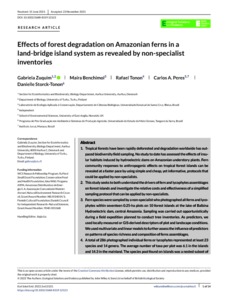Zuquim, Gabriela, Benchimol, Maíra, Tonon, Rafael, Peres, Carlos A. and Storck‐Tonon, Danielle (2022) Effects of forest degradation on Amazonian ferns in a land‐bridge island system as revealed by non‐specialist inventories. Ecological Solutions and Evidence, 3 (1). ISSN 2688-8319
![[thumbnail of Published manuscript]](https://ueaeprints.uea.ac.uk/83132/1.hassmallThumbnailVersion/Ecol_Sol_and_Evidence_2022_Zuquim_Effects_of_forest_degradation_on_Amazonian_ferns_in_a_land_bridge_island_system_as.pdf)  Preview |
PDF (Published manuscript)
- Published Version
Available under License Creative Commons Attribution. Download (1MB) | Preview |
Abstract
Tropical forests have been rapidly deforested and degradation worldwide has outpaced biodiversity field sampling. No study to date has assessed the effects of insular habitats induced by hydroelectric dams on Amazonian understory plants. Fern community responses to anthropogenic effects on tropical forest islands can be revealed at a faster pace by using simple and cheap, yet informative, protocols that could be applied by non-specialists. This study seeks to both understand the drivers of fern and lycophytes assemblages on forest islands and investigate the relative costs and effectiveness of a simplified sampling protocol that can be applied by non-specialists. Fern species were sampled by a non-specialist who photographed all ferns and lycophytes within seventeen 0.25-ha plots on 10 forest islands at the lake of Balbina Hydroelectric dam, central Amazonia. Sampling was carried out opportunistically during a field expedition planned to conduct tree inventories. As predictors, we used locally measured or GIS-derived descriptors of plot and landscape conditions. We used multivariate and linear models to further assess the influence of predictors on patterns of species richness and composition of ferns assemblages. A total of 286 photographed individual ferns or lycophytes represented at least 23 species and 14 genera. The average number of taxa per plot was 6.1 in the islands and 14.3 in the mainland. The species pool found on islands was a nested subset of the mainland fern community. Species richness was positively related to island size and negatively related to isolation and fire severity. Area, isolation and fire severity also significantly explained variation in community composition. The relative cost of the picture-based fern protocol applied was very modest (only 4% of the total expedition budget), even compared to the typically low cost of alternative field campaigns. We conclude that fern community structure in this forest archipelago was primarily driven by island size, isolation and fire disturbance. Moreover, we show that a simple sampling protocol carried out by a non-specialist can lead to inexpensive and highly reliable ecological data. This opens an avenue for crowdsourcing ecological fern data collections using a citizen science approach.
| Item Type: | Article |
|---|---|
| Uncontrolled Keywords: | sdg 15 - life on land ,/dk/atira/pure/sustainabledevelopmentgoals/life_on_land |
| Faculty \ School: | Faculty of Science > School of Environmental Sciences University of East Anglia Research Groups/Centres > Theme - ClimateUEA |
| UEA Research Groups: | Faculty of Science > Research Centres > Centre for Ecology, Evolution and Conservation |
| Related URLs: | |
| Depositing User: | LivePure Connector |
| Date Deposited: | 26 Jan 2022 01:17 |
| Last Modified: | 25 Oct 2025 07:32 |
| URI: | https://ueaeprints.uea.ac.uk/id/eprint/83132 |
| DOI: | 10.1002/2688-8319.12123 |
Downloads
Downloads per month over past year
Actions (login required)
 |
View Item |

 Tools
Tools Tools
Tools